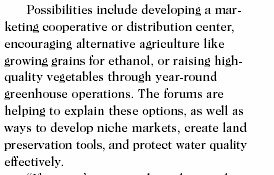
A national program crucial to helping farmers get off the pesticide treadmill and implement sustainable agriculture is on the chopping block. Last week, the Senate passed a budgetary "Continuing Resolution" which would immediately eliminate funding for the U.S. Department of Agriculture's Appropriate Technology Transfer for Rural Areas (ATTRA) -- the program that provides technical support on how to farm more sustainably!
Take Action Now! Take a few minutes to CALL your Congressional Representative and your Senators to urge USDA to support sustainable farming and fund ATTRA's modest $2.5 million program.
Right now Representative Boozman is circulating a sign-on letter in Congress to save ATTRA; he will take this message—with your Representative's signature— to USDA early the week of February 26. Senators are also sending individual letters to USDA with the same message. Phone calls like yours have protected ATTRA and other sustainable agriculture funding in the past.Please call today! Help preserve funding for this USDA program to support sustainable farming! It's easy to make a big impact.
Call the congressional switchboard at (202) 224-3121 and ask to be connected to the office of your representative and your two senators (this means 3 very quick calls). Ask to speak to the staffer handling appropriations. If he or she is unavailable, leave a message with your name, phone number and the quick message below.
Suggested Message
For your representative: Please ask Congressperson _________ to sign onto Congressman Boozman's letter asking USDA to restore full 2007 funding to the ATTRA sustainable agriculture information service. ATTRA is a national valuable source of information to farmers across the US about how to farm using sustainable practices, and it shouldn't be cut.
(Tell your Representative's staffer that they can contact Maggie Lemmerman at 202-225-4301 in Mr. Boozman's office to sign onto the letter.)
For your senators: Please ask Senator ___________ to send a letter asking USDA to restore full funding to the ATTRA sustainable agriculture information service. ATTRA is a national valuable source of information to farmers across the US about how to farm using sustainable practices, and it shouldn't be cut.
(Tell the staffer for your Senator that John Lewis in Senator Baucus' office (202) 224-2651 can provide information on the wording of the letter that Senator Baucus sent if that's helpful.)

